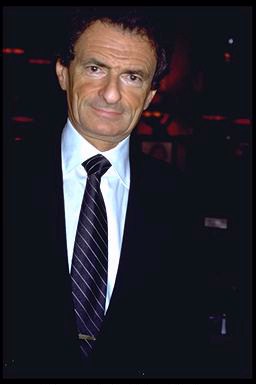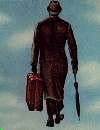JERZY KOSINSKI

©Archive Photos

Lying: A Life Story
Los Angeles Times, Sunday May 12, 1996
Home Edition
Book Review, Page 3
Type of Material: Book Review
He loved to tell outrageous lies, particularly to the rich, intellectual and famous. They were so eager to be entertained, he explained, that they willingly suspended disbelief, and they were so confident of their superiority that they deserved to be played for fools. "Court jester" to his powerful American friends, that's how Jerzy Kosinski sometimes referred to himself.
Even the truths of Kosinski's life are astonishing in their variety and complexity. Though he was never the mute, brutalized child hero of "The Painted Bird," he probably really did escape being killed in Sharon Tate's house the night of the Manson murders because, according to James Park Sloan, he missed his plane to Los Angeles. A skilled photographer, Kosinski really was invited by the dying Nobel Prize-winning French biochemist Jacques Monod to document his final hours, although we are not told what Monod expected him to do with the photographs.
And after arriving as a penniless foreigner to go to graduate school at Columbia, Kosinski really did live out the American dream, marrying a millionaire socialite (from whom he was subsequently divorced, and who later committed suicide), earning national awards and huge sums of money for his books and a screenplay, on the way achieving that greatest of dreams, to be a movie star, playing a small but important role role in "Reds."
His suicide in 1991 at age 58 shocked the outside world but did not surprise many friends.
Kosinski came to the U.S. in 1957, from his native Poland. Here, as he had there, he gradually became known for a spectrum of sociopathic behavior ranging from mere megalomania to brutal sexual coercion, fraud and plagiarism. Yet he was so convincing that his powerful supporters (including Yale University and the New York Times) believed his side of these accounts for 25 years before evidence was finally published in the Village Voice showing the depth of his cons and dishonesty.
According to Sloan, Kosinski couldn't help being a pathological liar and a control freak. Born Jerzy Nitodem Lewintopf in Lodz in 1933, this son of well-to-do secular, intellectual Jews learned by the age of 9 that to live, he must not be himself. At the beginning of World War II, his father carefully invented a Gentile identity that allowed his family to survive the Holocaust. Sloan argues that Kosinski's psyche was permanently damaged by the absolute necessity of his disguise as the Catholic Jurek Kosinski; he must hide his otherness--especially his circumcised penis--for to be found out was death. The central metaphor of Kosinski's first novel, "The Painted Bird," elaborates a medieval Polish legend: If a captured crow is beautifully painted and released to go back to its flock, the other crows will attack and kill it because it is different.
No wonder Kosinski lost track of truth. Truth was dangerous. Survival depended on play-acting and lies. So he became an expert actor and storyteller. Paradoxically, since his father had chosen Kosinski, the Polish equivalent of Smith, as the family's new name, Kosinski could tolerate disguise, but not anonymity. Thereafter, he created many selves, each more beautifully painted than the last, and although his gloss and shimmer attracted others, often his uniqueness made him suspect. In school in Poland, later at Columbia and most significantly when his novels became bestsellers, his masks eventually were questioned, and his audience turned on him, furious at his hubris.
Rumors about his plagiarisms and ghostwriters were rampant for at least 10 years before a 1982 article in the Village Voice revealed that Kosinski, who won the 1969 National Book Award for "Step" and whose novel and prize-winning screenplay "Being There" became a hit movie, couldn't write English well enough to put his words on paper. The striking stylistic differences apparent from one novel to another can be explained by the fact that he often changed the poorly paid, never-credited "editors" with whom he would sketch out a story line and collaborate as they filled in the details.
As rumors of this practice spread, some writers in his stable were even required to sign a document saying that they had never given more than superficial "editorial assistance." The Voice also made public the 1975 discoveries by Barbara Tepa (now Lupack), a bilingual doctoral candidate whose unpublished doctoral thesis revealed that in many cases, long passages of Kosinski books were more or less directly translated from Polish sources unknown to English speakers.
The importance of scrupulously recognizing authors and secondary sources in works of fiction has long been questioned by writers, and today's postmodern novels have rendered the issue so fluid that Kosinski's borrowings are moot, from a "moral" point of view. Sloan correctly points out that the measure of Kosinski's creativity will be how his books survive as literature, even if their "author" can best be described as a committee. Sloan compares Kosinski to Balzac, whom he calls another "congenial, incorrigible liar." Although he documents that most if not all the accusations leveled at Kosinski are true, Sloan devotes his meticulous research and careful scholarly readings of Kosinski's work to explaining why Kosinski was a compulsive liar and to ferreting out the truth, comparing it to the elaborate and multiple personal mythology Kosinski wove into his life as well as his "autobiographical" fiction.
Even without the lies, Kosinski was a seriously eccentric man. Unable to maintain close friendships, he most often played the role of trickster, showing off symbolic skills like his uncanny ability to hide himself in a room so that others were completely unable to find him. His stories and pranks repeatedly enchanted and confounded the revolving groups of prestigious social, intellectual and political acquaintances he ushered in and out of his life about every two years. "Once he went through his repertory" Sloan writes, "it was time to move on. He tended to use up his stories, or perhaps more accurately, to use up his audience."
Given his charismatic, self-destructive subject, Sloan writes with a peculiarly flat affect. He manages to remove the emotional tension from even the most dramatic events, balancing and defusing the most scandalized criticisms and delicately euphemizing all references to Kosinski's obsessive sadomasochistic sexual behavior, described in elaborate detail in Kosinski's own writing. Sloan's studiously neutral position ends up sounding like an apologia for Kosinski. A former National Book Award finalist himself, Sloan, a professor of English at the University of Illinois, knew Kosinski for 20 years. This biography at times seems like a justification of the misdeeds of a brilliantly flawed friend.
Copyright, The Times Mirror Company; Los Angeles Times, 1996.
Regarding Joan Mellen's shallow review of James Park Sloan's flinty and perverted biography of Jerzy Kosinski ("Imploding Space," May 3):
"To Chayym, my brother, my friend, my mentor with love and affection, Jerzy, New York, 1970." This is Kosinski's inscription in the flyleaf of the copy of The Painted Bird, which he gave me. Book and dedication were given me because I was one of his editors.
I met Jerzy in the late 1960s, and was asked by him to edit his National Book Award winning novel Steps, and then Being There. I did this; no more and no less. In later years, the Village Voice tried desperately to pump sewage out of me, urging me to say that I'd ghost-written for Jerzy. I refused summarily because I had only edited for him. And become his close friend.
I knew him to be brilliant, charming, generous, witty. His relationship with his beloved Kiki, who understood and ministered to him, was warm, open, of substance, mutually nourishing. He was also mercurial, quixotic, uncertain, tense, anguished, despondent. He sought after the rich and the famous; they pursued him in turn. He courted fame itself, and succeeded.
He dazzled, confounded, invented, fantasied. I never paid attention to the hoopla and tinsel, the surface Jerzy. I never cared whether he was a Jew or not. What mattered was that I was a Jew and saw into his essence. [I] saw that before and beyond it all, Kosinski was a tormented, ultimately broken man who managed to crawl from under the iron-shadow of Nazi Europe and survive in body, but not in spirit.
Whether he personally was the "hero" in The Painted Bird is not the point. In this shattering novel, Kosinski invokes the terror and suffering of a million and a half murdered Jewish children. Mellen's use of the word "cozily" to describe Jewish survival in war-time Poland is nothing short of obscene.
Kosinski had many enemies. During the years I knew him, he told me that the Poles were out to kill him because of The Painted Bird. And he did have detractors. Like Joyce, he was envied because he'd created a modern masterpiece. Like Freud, he was hated and feared because he wrote about the despicable species of which he was a part.
He was always ill in spirit and physically. In the end, he succumbed.
I will continue to remember him, to admire him, to mourn him, to
love him. And to loathe the evil and indifference in the men who robbed
him of life.
